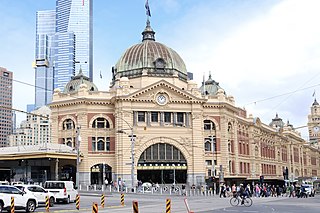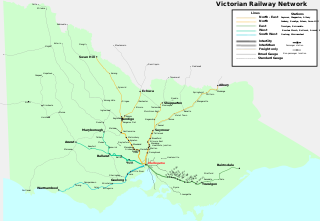
Hobsons Bay is a small open bay in Victoria, Australia, and is the northernmost part of the larger Port Phillip Bay. Its western and eastern boundaries are marked by Point Gellibrand in Williamstown and Point Ormond in Elwood respectively, and defines the coastal margin of the Melbourne suburbs of Wiliamstown, Newport, Port Melbourne, Albert Park, Middle Park, St. Kilda West, St. Kilda and Elwood. The Yarra River flows into Hobsons Bay.

Port Melbourne is an inner-city suburb in Melbourne, Victoria, Australia, 3 km (2 mi) south-west of the Melbourne central business district, located within the Cities of Melbourne and Port Phillip local government areas. Port Melbourne recorded a population of 17,633 at the 2021 census.

South Yarra railway station is a commuter railway station and the junction point for the Cranbourne, Frankston, Pakenham and Sandringham lines, part of the Melbourne railway network. It serves the southern Melbourne suburb of South Yarra in Victoria, Australia. South Yarra is a ground-level premium station featuring six platforms, with two island platforms and two side platforms accessible by an overground concourse. It opened on 22 December 1860.

St Kilda station is a current tram stop and former railway station, located in the Melbourne suburb of St Kilda, Australia, and was the terminus of the St Kilda railway line in the Melbourne suburban rail system. It is one of the oldest surviving railway station buildings in Victoria. The building is currently used as retail premises, while the platform serves as stop 132 on tram route 96.

The Sandringham line is a commuter railway line in the city of Melbourne, Victoria, Australia. Operated by Metro Trains Melbourne, it is the city's fourth shortest metropolitan railway line at 17.9 kilometres (11.1 mi). The line runs from Flinders Street station in central Melbourne to Sandringham station in the south-east, serving 14 stations via South Yarra, Balaclava, Elsternwick, and Brighton. The line operates from approximately 5am to 12am, daily, with 24 hour service available on Friday and Saturday nights. Services run every 7–8 minutes during peak hour, with services running every 15 minutes during the inter-peak period on weekdays, and every 20 minutes at night and during the day on weekends. Additionally, services run every 60 minutes overnight on Friday and Saturday nights as part of the Night Network. Trains on the Sandringham line run with a two three-car formations of Comeng or Siemens Nexas trainsets.

The Melbourne rail network is a metropolitan suburban and freight rail system serving the city of Melbourne, Victoria, Australia. The metropolitan rail network is centred around the Melbourne central business district (CBD) and consists of 221 railway stations across 16 lines, which served a patronage of 182.5 million over the year 2023–2024. It is the core of the larger Victorian railway network, with regional links to both intrastate and interstate rail systems.

Rail transport in the Australian state of Victoria is provided by a number of railway operators who operate over the government-owned railway lines. The network consists of 2,357 km of Victorian broad gauge lines, and 1,912 km of standard gauge freight and interstate lines; the latter increasing with gauge conversion of the former. Historically, a few experimental 762 mm gauge lines were built, along with various private logging, mining and industrial railways. The rail network radiates from the state capital, Melbourne, with main interstate links to Sydney and to Adelaide, as well as major lines running to regional centres, upgraded as part of the Regional Fast Rail project.

Station Pier is a historic Australian pier on Port Phillip, in Port Melbourne, Victoria. Opened in 1854, the pier is Melbourne's primary passenger terminal, servicing interstate ferries and cruise ships, and is listed on the Victorian Heritage Register.

The Sandridge Bridge is a historic bridge, which originally carried railway lines over the Yarra River in Melbourne, Victoria, Australia. It runs diagonally to the river and is 178.4 metres (585 ft) long. In 2006, it was redeveloped as a pedestrian and cycle path, featuring public art. It is the third bridge on the site and is listed on the Victorian Heritage Register.

Princes Bridge was a Melbourne railway station built in 1859 and was the terminus for all trains on what are now the Mernda and Hurstbridge lines. The station was named after the adjacent Princes Bridge, which crosses the Yarra River. Originally Princes Bridge station was isolated from Flinders Street station, even though it was adjacent to it, sited just on the opposite side of Swanston Street. Some years later the railway tracks were extended under the street to join the two stations, and Princes Bridge slowly became amalgamated into the larger Flinders Street station. This process was completed in May 1997.
The St Kilda and Brighton Railway Company was a railway company in Victoria, Australia. The company opened a line from St Kilda Railway Station in Melbourne, Australia to Bay Street in 1859 and Beach in 1861.
The Melbourne and Suburban Railway Company was a railway company in Victoria, Australia. The company opened a line from Princes Bridge railway station in Melbourne, Australia to Punt Road (Richmond) and over the Yarra River to South Yarra in 1859, with extensions south to Prahran in 1859 and Windsor in 1860, connecting with the 1859 St Kilda and Brighton Railway Company's line from St Kilda to Bay Street, which was extended to Beach Station in 1861. They also built an eastward extension to Hawthorn by 1861. This company ran into difficulties almost immediately, and was bought by the Melbourne Railway Company in 1862.
The Port Melbourne railway line is a former heavy rail line in Melbourne, Australia, opened in September 1854, that is now a light rail line. It was instigated by the Melbourne and Hobson's Bay Railway Company to carry passengers arriving in Victoria at Station Pier and to alleviate the high cost of shipping goods using small vessels up the Yarra River to Melbourne. The line's conversion to light rail occurred in 1987; it is now served by tram route 109.
The St Kilda railway line is a former railway line in Melbourne, Australia.

Beacon Cove is a light rail station in the Melbourne suburb of Port Melbourne located on the former Port Melbourne line, the first significant railway in Australia.
William Elsdon was an English civil engineer. He was also an architect and railway engineer who worked predominantly on early railways in Victoria, Australia.

Emerald Hill was an electoral district of the Victorian Legislative Assembly, Australia. It covered part of the inner-city suburb South Melbourne and consisted part of the previous Electoral district of South Melbourne which was abolished in 1859..
Robertson, Martin and Smith was an engineering firm in Melbourne in the second half of the nineteenth century. The company manufactured the first steam locomotive to be built in Australia.

Melbourne and Hobson's Bay Railway Company 2-2-2WT (1854) was the first locomotive operated after the inauguration of a public railway line in Australia. It had 7+7⁄8 in (200 mm) diameter cylinders and was capable of producing 30.0 horsepower, reaching 25 mph (40 km/h) and hauling 130 tonnes.
This was a group of 18 2-4-0WT passenger steam locomotives, built by Robert Stephenson & Company and an extra locomotive built from spare parts supplied with the other 18. These locomotives not only provided the bulk workforce of the early private railway operators in Victoria, but upon their withdrawal they once again proved themselves as useful as contractors locos building some of the railway lines for the then expanding Victorian Railway network.
















